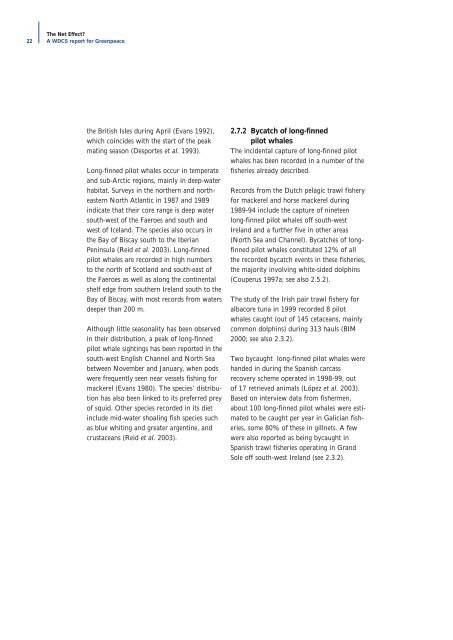The Net Effect? - Whale and Dolphin Conservation Society
The Net Effect? - Whale and Dolphin Conservation Society
The Net Effect? - Whale and Dolphin Conservation Society
You also want an ePaper? Increase the reach of your titles
YUMPU automatically turns print PDFs into web optimized ePapers that Google loves.
22<br />
<strong>The</strong> <strong>Net</strong> <strong>Effect</strong>?<br />
A WDCS report for Greenpeace<br />
the British Isles during April (Evans 1992),<br />
which coincides with the start of the peak<br />
mating season (Desportes et al. 1993).<br />
Long-finned pilot whales occur in temperate<br />
<strong>and</strong> sub-Arctic regions, mainly in deep-water<br />
habitat. Surveys in the northern <strong>and</strong> northeastern<br />
North Atlantic in 1987 <strong>and</strong> 1989<br />
indicate that their core range is deep water<br />
south-west of the Faeroes <strong>and</strong> south <strong>and</strong><br />
west of Icel<strong>and</strong>. <strong>The</strong> species also occurs in<br />
the Bay of Biscay south to the Iberian<br />
Peninsula (Reid et al. 2003). Long-finned<br />
pilot whales are recorded in high numbers<br />
to the north of Scotl<strong>and</strong> <strong>and</strong> south-east of<br />
the Faeroes as well as along the continental<br />
shelf edge from southern Irel<strong>and</strong> south to the<br />
Bay of Biscay, with most records from waters<br />
deeper than 200 m.<br />
Although little seasonality has been observed<br />
in their distribution, a peak of long-finned<br />
pilot whale sightings has been reported in the<br />
south-west English Channel <strong>and</strong> North Sea<br />
between November <strong>and</strong> January, when pods<br />
were frequently seen near vessels fishing for<br />
mackerel (Evans 1980). <strong>The</strong> species’ distribution<br />
has also been linked to its preferred prey<br />
of squid. Other species recorded in its diet<br />
include mid-water shoaling fish species such<br />
as blue whiting <strong>and</strong> greater argentine, <strong>and</strong><br />
crustaceans (Reid et al. 2003).<br />
2.7.2 Bycatch of long-finned<br />
pilot whales<br />
<strong>The</strong> incidental capture of long-finned pilot<br />
whales has been recorded in a number of the<br />
fisheries already described.<br />
Records from the Dutch pelagic trawl fishery<br />
for mackerel <strong>and</strong> horse mackerel during<br />
1989-94 include the capture of nineteen<br />
long-finned pilot whales off south-west<br />
Irel<strong>and</strong> <strong>and</strong> a further five in other areas<br />
(North Sea <strong>and</strong> Channel). Bycatches of longfinned<br />
pilot whales constituted 12% of all<br />
the recorded bycatch events in these fisheries,<br />
the majority involving white-sided dolphins<br />
(Couperus 1997a; see also 2.5.2).<br />
<strong>The</strong> study of the Irish pair trawl fishery for<br />
albacore tuna in 1999 recorded 8 pilot<br />
whales caught (out of 145 cetaceans, mainly<br />
common dolphins) during 313 hauls (BIM<br />
2000; see also 2.3.2).<br />
Two bycaught long-finned pilot whales were<br />
h<strong>and</strong>ed in during the Spanish carcass<br />
recovery scheme operated in 1998-99, out<br />
of 17 retrieved animals (López et al. 2003).<br />
Based on interview data from fishermen,<br />
about 100 long-finned pilot whales were estimated<br />
to be caught per year in Galician fisheries,<br />
some 80% of these in gillnets. A few<br />
were also reported as being bycaught in<br />
Spanish trawl fisheries operating in Gr<strong>and</strong><br />
Sole off south-west Irel<strong>and</strong> (see 2.3.2).

















